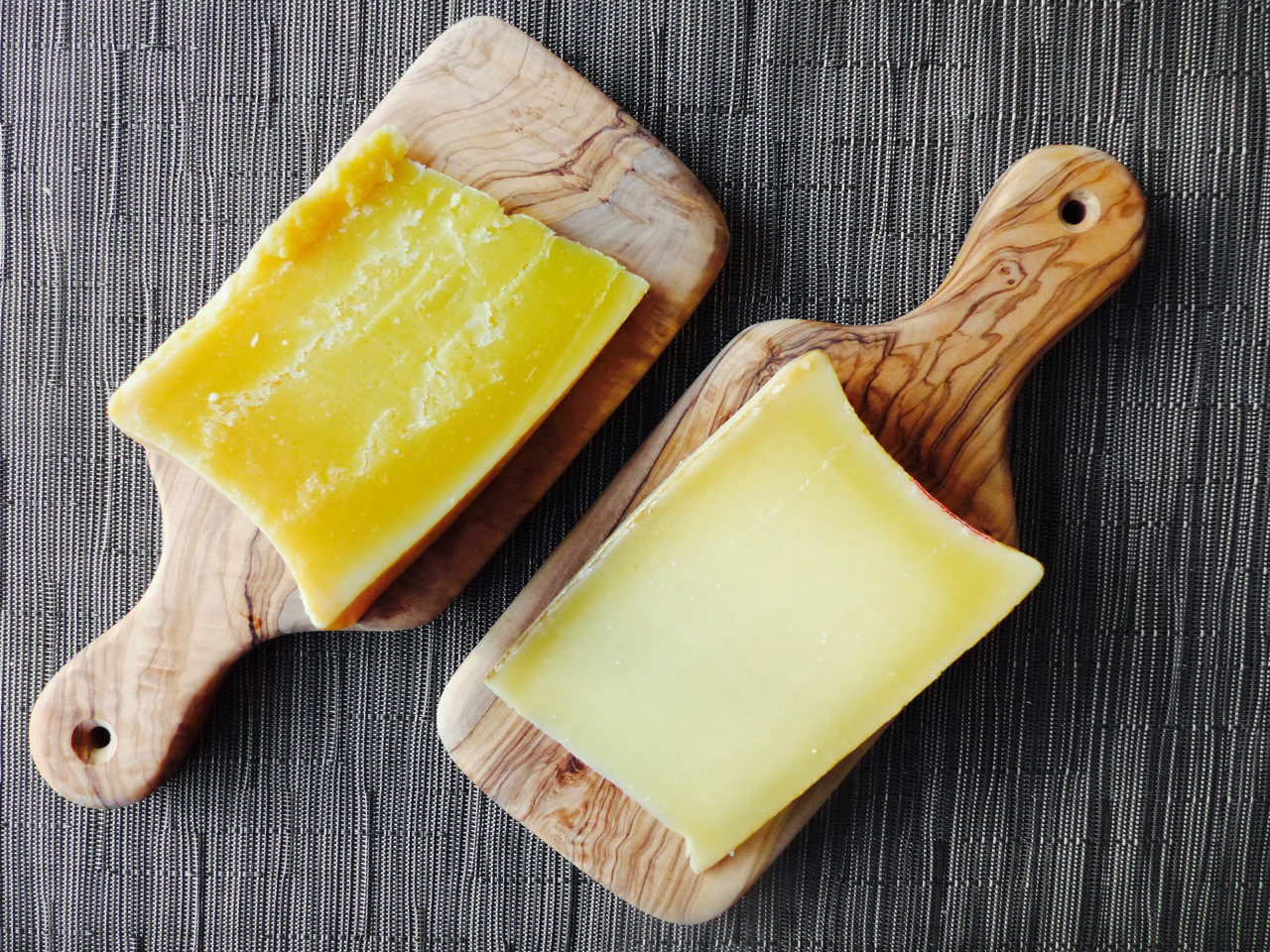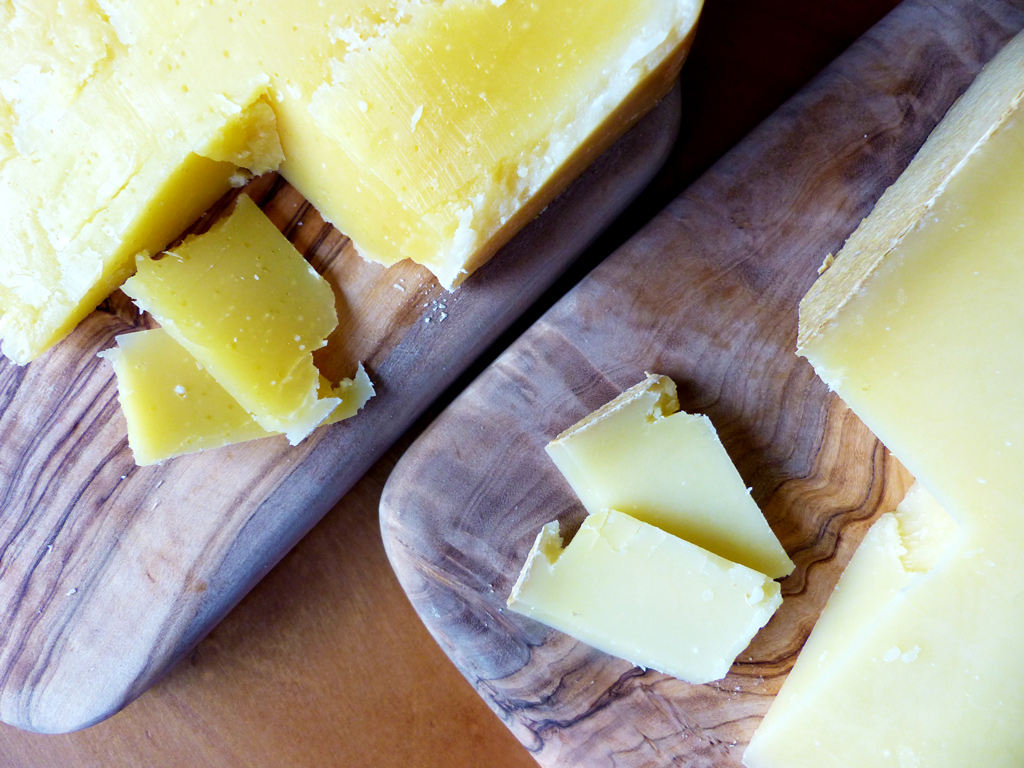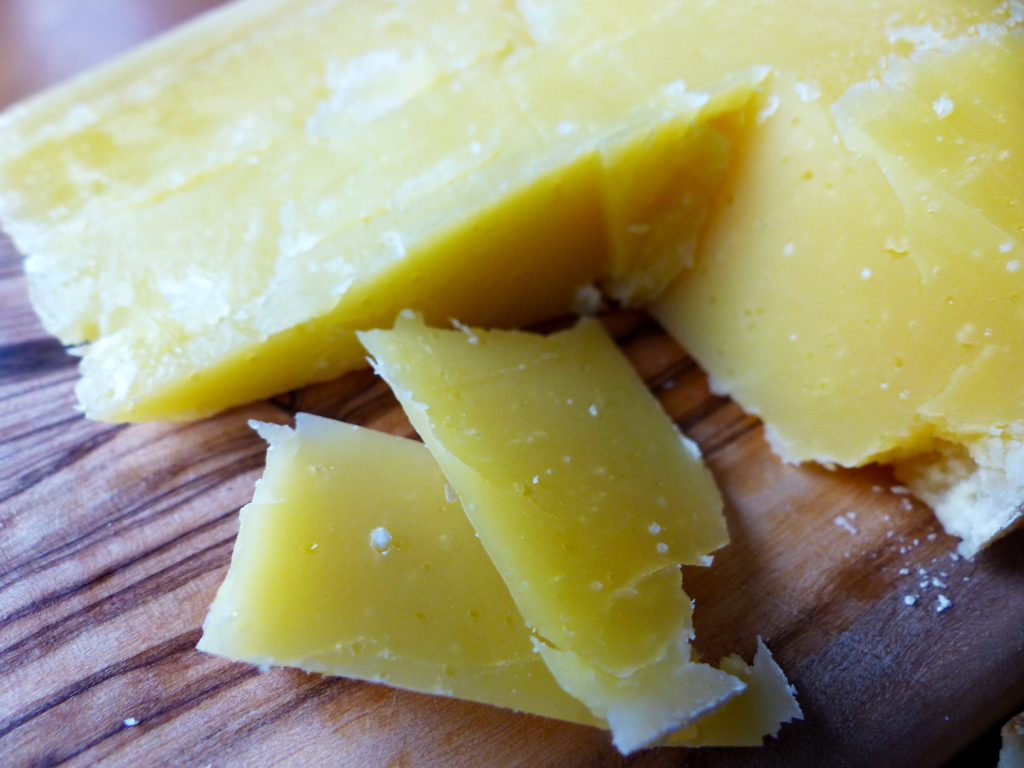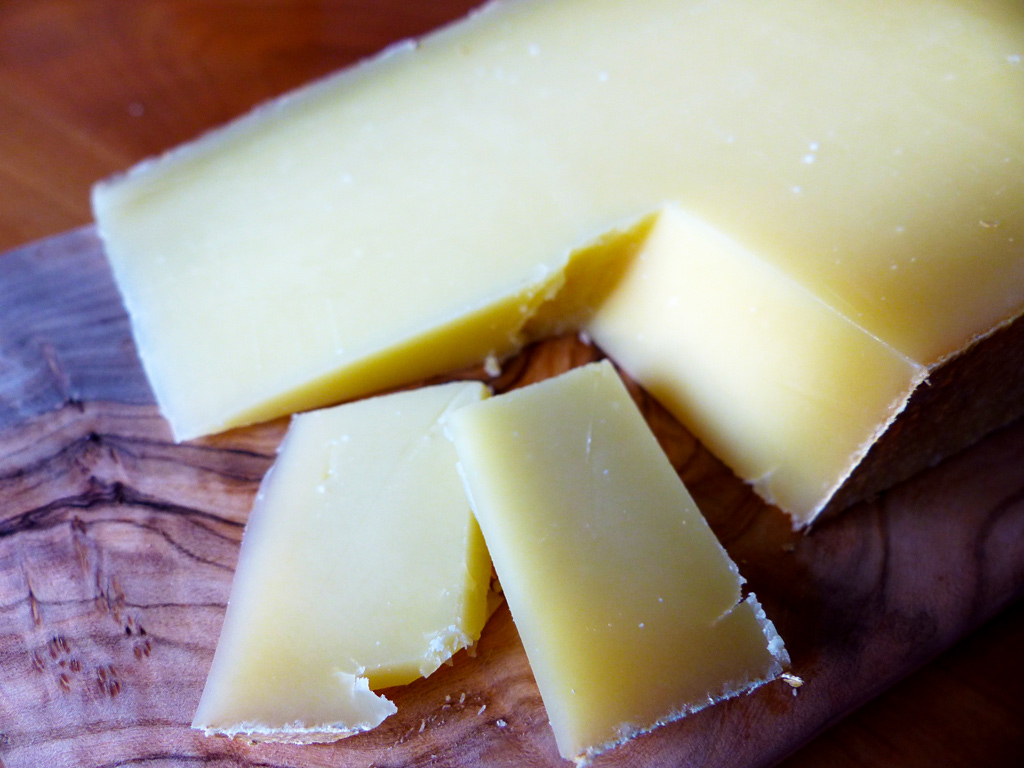
Tarentaise from Thistle Hill Farm (left) and Spring Brook Farm
The Tarentaise creation story begins in an alpine meadow, either eighteen years ago or sixteen centuries ago, depending on how you count.
Let’s start many centuries ago, when mountain cheeses first bloomed gloriously into the world. Each spring, in the tiny burgs that dot the Alpine valleys, farmers would gather their animals into herds and lead them to lush high pastures, where they would graze until autumn’s copper leaves blew them all downhill again. This annual pageant became known as transhumance (literally: across the humus), and the forage of grasses spangled with herbs and flowers imbued the milk with an ineffable summery sweetness, different from one vallée to the next.As the cows munched their way across the uplands, the cowherds busied themselves with twice-daily milkings, and, critically, the working of that liquid into something that could be stored and transported; namely: cheese.
There were necessarily some constraints. Since all supplies had to be hauled uphill to the cheesemaking chalets, the cheeses evolved to use a meager amount of salt. And because the wheels had to be carted downhill later, they evolved to be large (one wheel’s easier to juggle than ten). Their paste had to be firm but elastic enough to handle transport, and their concave shape was another clever devising, allowing the wheels to be easily lashed with a rope to their downslope conveyance, be it animal, often mule, or mechanical.
And they’re dense. These are pressed, cooked-curd cheeses, ones whose moisture is driven out not only by cutting the curd into tiny grains but also by heating it, which speeds the expulsion of whey, and also by pressing in molds. As the wheels age they’re washed with a mix of salt and culture, a slurry called morge, which develops the rind and encourages the proper microbial growth, ensuring both sanity and longevity.
These alpine, or alpage, cheeses include Gruyère, Emmentaler, and Appenzeller (Swiss); Comté and Beaufort (French); and Fontina Val d’Aosta (Italian). The largest wheels, of Comté, for example, can reach 100 pounds, although 20 is more common. They tend to be nutty, dense, and savory but not too salty, with a hint of brown butter from the heating step. They may have tiny holes from gases created by their microflora. Their color is saturated yellow, an expression of the forage rich in beta-carotene and other nutrients.
In Europe their making is strictly controlled by PDO or AOP regulation. Beaufort, for example, cannot come from anywhere else but Beaufort, France.

Tarentaise from Thistle Hill Farm (left) and Spring Brook Farm
John is a lawyer, a graduate of Middlebury College and Vermont Law School, where he and Janine had met. In 1986, after John bailed from a high-pressure job at a Boston legal firm, the couple bought the 83-acre farm and filled it with cattle, cows, and children. They were now itching to make a great Alpine-style cheese at home in Vermont.
Their quest lands them in the cottage of a fermier cheesemaker in Beaufort, in the Vallée de la Tarentaise, just northeast of Grenoble, France. He makes his alpage cheeses by hand-milking one hundred cows, twice a day, all summer long.
“To make Beaufort is too meticulous for you,” the cheesemaker told them.
It was all the challenge they needed.
Back home, the Putnams got to work, adapting the method to their American context. They imported a 200-year-old, 850-liter copper cauldron to cook the curds. They began moving their two dozen Jersey cows onto fresh pasture twice daily, hand milking them into buckets. They transferred the curds into molds by hand to limit the trauma of pumping. They used a rennet devised from whey from prior makes—a traditional practice—and they washed their wheels twice weekly with a morge that included a culture sourced from France.
They made their first cheese on July 5, 2002. They called it Tarentaise in a nod to the location that inspired it.
The cheese swiftly earned accolades, winning Silver at the 2003 American Cheese Society competition, and along came national press. Demand for the cheese increased, but the Putnams were committed to farmstead production and wanted to stay small. And that’s where Spring Brook Farm comes in.
In 2007, the Putnams agreed to license the recipe and method for Tarentaise to a farm twenty miles away in Reading, Vermont. Spring Brook’s thousand-acre property is managed as an educational nonprofit that brings city children to the countryside to learn about food and farming. They have about a hundred registered Jersey cows, half of which are milking, and in addition to the staff and kids, the place is also peopled by goats, pigs, and poultry.
Spring Brook began producing the cheese according to the Putnam’s procedure, but with a little less hand work. The milk is raw and comes only from the farm, and the curd is cooked copper vats, but they use an animal rennet, and they pump the curd—gently—into molds. Their wheels age from nine to twelve months and are washed sixty times during affinage.
The two farm’s cheeses share a kinship, but they are, of course, different (see my tasting notes below). Like their alpage predecessors, they differ from one valley to the next. But people are part of the terroir equation, too, and how they interpret a recipe adds to the cheese’s personality, expanding its definition. Method adapts to context.The food writer Sam Chapple-Sokol recently observed, in the new food journal Kitchen Work, that by licensing production, “What the Putnams were effectively doing was not creating a new brand, but a new style—Tarentaise doesn’t refer to the cheese’s name, but its category.”
In other words, the cheese was no longer one farm’s vision. It was no longer “our cheese,” it was now just “a cheese.” And in sharing their process with another farm, the Putnams had not simply boosted Tarentaise, they’d also let go of it. They had sent the cheese out of their creamery and into the world, to see what it would become.
Ironically, this makes the cheese even more traditional–or perhaps classical is the better word. Because for centuries, Alpine farmers pooled herds and shared chalets and collectively made as much cheese as possible to tide them through winter. Sharing was baked into the process, into the evolution of a cheese. Who invented Beaufort? Nobody, and everybody.
And so with Vermont Tarentaise.
Tasting Tarentaise

Tarentaise from Thistle Hill Farm
Thistle Hill Farm Tarentaise
The aromas are fruity and darkly mushroomy, redolent of the cave. The paste is dry and grainy, dotted with crackly tyrosine crystals that pop against the deep, saturated yellow. Although the cheese looks craggy and dense, it feels almost spongy on the tongue, lifted by snappy acidity and a distinct grassiness. Not as nutty as the Spring Brook cheese, and better with slightly higher-acid wines.
$19.50/lb.

Tarentaise from Spring Brook Farm
Spring Brook Farm Tarentaise
The paste is pale, creamy yellow and the fragrance is nutty with a hint of white mushroom. The springy, elastic paste is smoother than that of the Thistle Hill, but is likewise studded with a few crunchy crystals. The flavor is distinctly nutty and is less tangy, which allows it to pair with more tannic wines. The finish is fruity and grassy.
$24/lb.
Editor’s note, August 2017: Spring Brook Farm Tarentaise Reserve won Best of Show in the 2017 American Cheese Society Awards.
Pairing Wine With Tarentaise
Tarentaise cheese can partner amicably with a range of white, red, rosé, sparkling, and oxidized wines.
The cheese’s notes of nut and caramel tie to barrel-fermented or neutral barrel-aged white wines, particularly Chardonnay from Burgundy or the New World. It’s good with other more substantial whites, like white Hermitage or the Côtes du Rhône, or wines with stone fruit notes like those made from Chenin Blanc or Viognier. Off-dry Riesling, vintage Champagne, fino Sherry, and Vin Jaune are good bets, too.
For red wines, seek ones with medium berry fruit, modest tannins, and solid acidity. Pinot Noir and Gamay (Cru Beaujolais) are perfect; New World Syrah, Barbera, and Monastrell work to pick up the cheese’s earthiness.
Or, try a Vermont wine, especially white La Crescent, with its honeyed tones, or red Marquette with its refreshing berry acidity. Perhaps the perfect match? The pet nats made by a neighbor in central Vermont, La Garagista: Ci Confonde blanc or rosé. Terroir, baby.
Find Sam Chapple-Sokol’s essay, “Tarentaise: A Study in American Terroir,” in Kitchen Work 1:1 (Fall 2016): 67–72.
For more information on Vermont cheese and cheesemakers, see The Vermont Cheese Book, by Ellen Ecker Ogden (2007) and The Cheeses of Vermont, by the late Henry Tewksbury (2002), both from The Countryman Press of Woodstock, Vermont. These books are slightly dated, but offer the most comprehensive survey available of the state’s cheese producers.




Thank you for this article. Laura and I have had the Spring Brook Tarentaise, and enjoyed it with as wide a range of wines as you describe. Now it’s time to hunt down the Thistle Hill version.
Excellent, David. Such great cheeses. Enjoy!